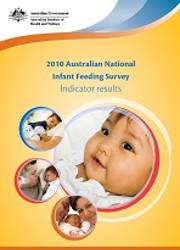Summary
The 2010 Australian National Infant Feeding Survey, conducted in 2010–11, was the first large-scale, specialised, national survey of infant feeding practices and related attitudes and behaviours conducted in Australia. The main aim of the survey was to provide baseline data on estimates of the prevalence and duration of breastfeeding and other feeding practices adopted by mothers/carers.
Main findings
Initiation, duration and intensity of breastfeeding
- Breastfeeding was initiated for 96% of children aged 0–2 years.
- Around 69% of infants were still receiving some breastmilk at 4 months of age, although only 39% were exclusively breastfed to 3 months (less than 4 months), and around 60% were still receiving some breastmilk at 6 months, but only 15% were exclusively breastfed to 5 months (less than 6 months).
- A total of 47% of infants were predominantly (fully) breastfed to 3 months (less than 4 months), dropping to 21% predominantly breastfed to 5 months (less than 6 months).
Introduction of non-human milk and other fluids/foods
In the day before the survey:
- About 40% of infants aged 1 month old received non-human milk or infant formula, with the rate rising gradually to 55% at 6 months. Nearly 80% of children aged 12 months received non-human milk or infant formula.
- Less than 1% of infants aged 1 month old had consumed soft/semi-solid/solid food, rising to 35% of infants aged 4 months, 92% of infants aged 6 months and 95% of children aged 12 months.
Characteristics associated with breastfeeding practices
- Higher rates of initiation and higher intensity feeding for longer periods were associated with:
- mothers/carers aged 35 and over
- mothers/carers with tertiary education, and higher incomes
- infants who did not regularly use a dummy.
- These same groups were associated with lower and later rates of introduction of non-human milk and soft/semi-solid/solid foods.
Factors influencing breastfeeding practices
- The reasons most cited for giving the child breastmilk were ‘healthier for child’ (94%), ‘convenient’ (64%) and ‘helps with mother–infant bonding’ (64%).
- The reasons most cited for not breastfeeding were ‘previously unsuccessful experience’ (38%), ‘so my partner can share feeding’ (29%) and ‘infant formula as good as breastmilk’ (26%).
Summary
Main findings
- Initiation, duration and intensity of breastfeeding
- Introduction of non-human milk and other fluids/foods
- Characteristics associated with breastfeeding practices
- Factors influencing breastfeeding practices
1. Introduction
- 2010 Australian National Infant Feeding Survey
- About this report
2. Overview of indicator results
- Indicator 1: Proportion of children ever breastfed
- Indicator 2: Proportion of children receiving any breastmilk at each month of age, 0–24 months
- Indicator 3: Proportion of children exclusively breastfed to each month of age, 0–6 months
- Indicator 4: Proportion of children predominantly breastfed to each month of age, 0–6 months
- Indicator 5: Proportion of children receiving soft/semi-solid/solid food at each month of age, 0–12 months
- Indicator 6: Proportion of children receiving non-human milk or formula at each month of age, 0–12 months
3. Detailed indicator results
- Introduction
4. Factors influencing infant feeding practices
- Attitudes and barriers to breastfeeding
- Factors related to early initiation to breastfeeding
Appendix A Explanatory notes
- Introduction
- Survey objectives
- Methodology
- Analytical approach
- Access to the survey data
End matter: Acknowledgments; Abbreviations; Symbols; Glossary; References; List of tables; List of figures; Related publications; Survey



